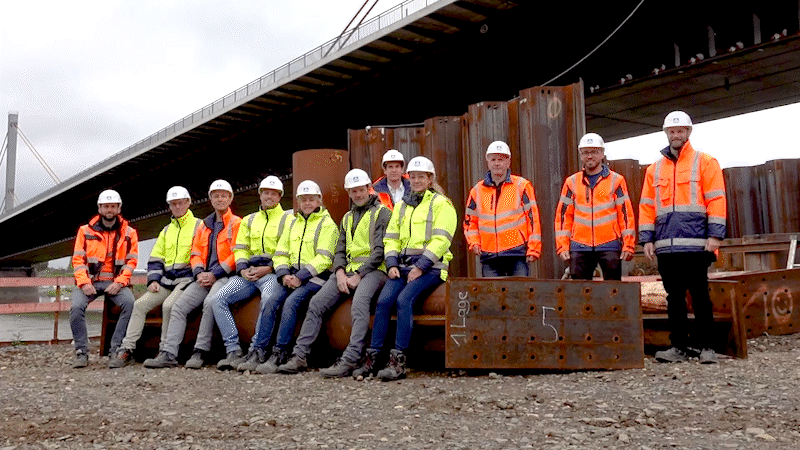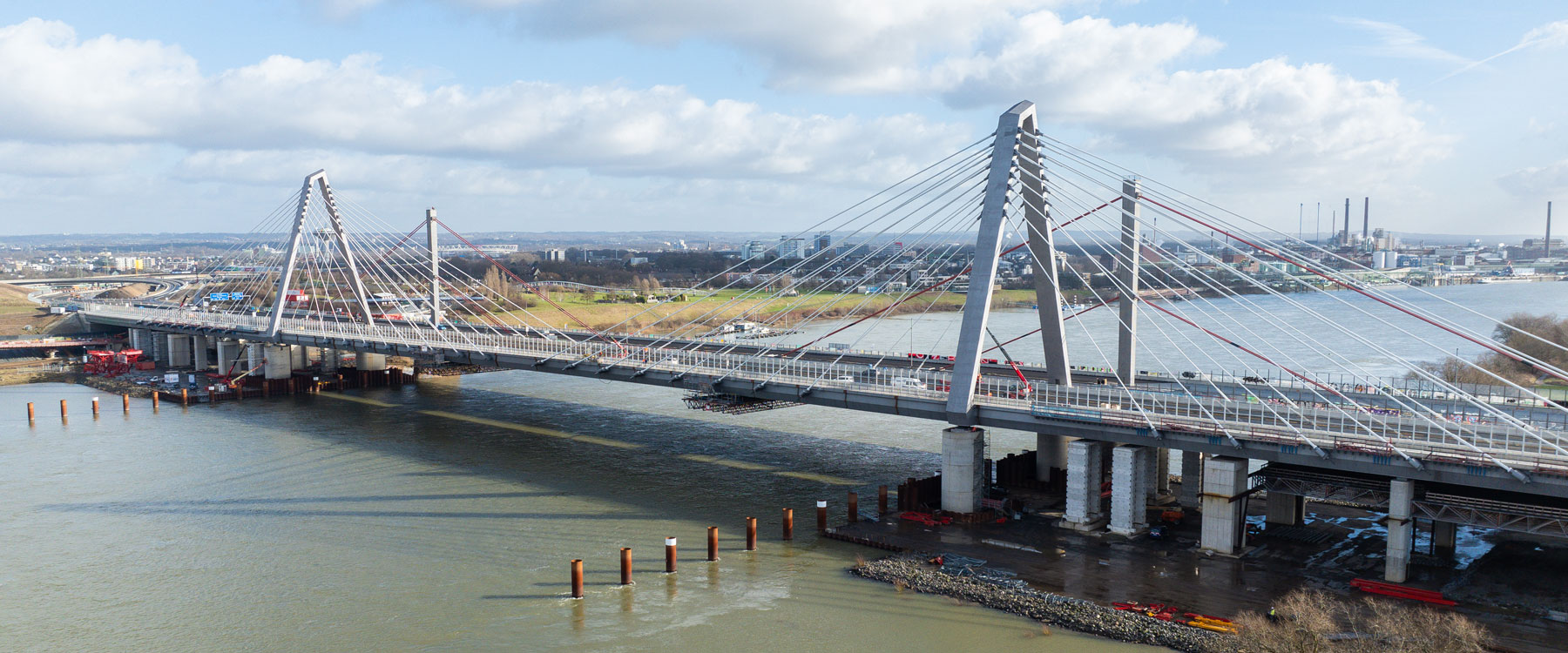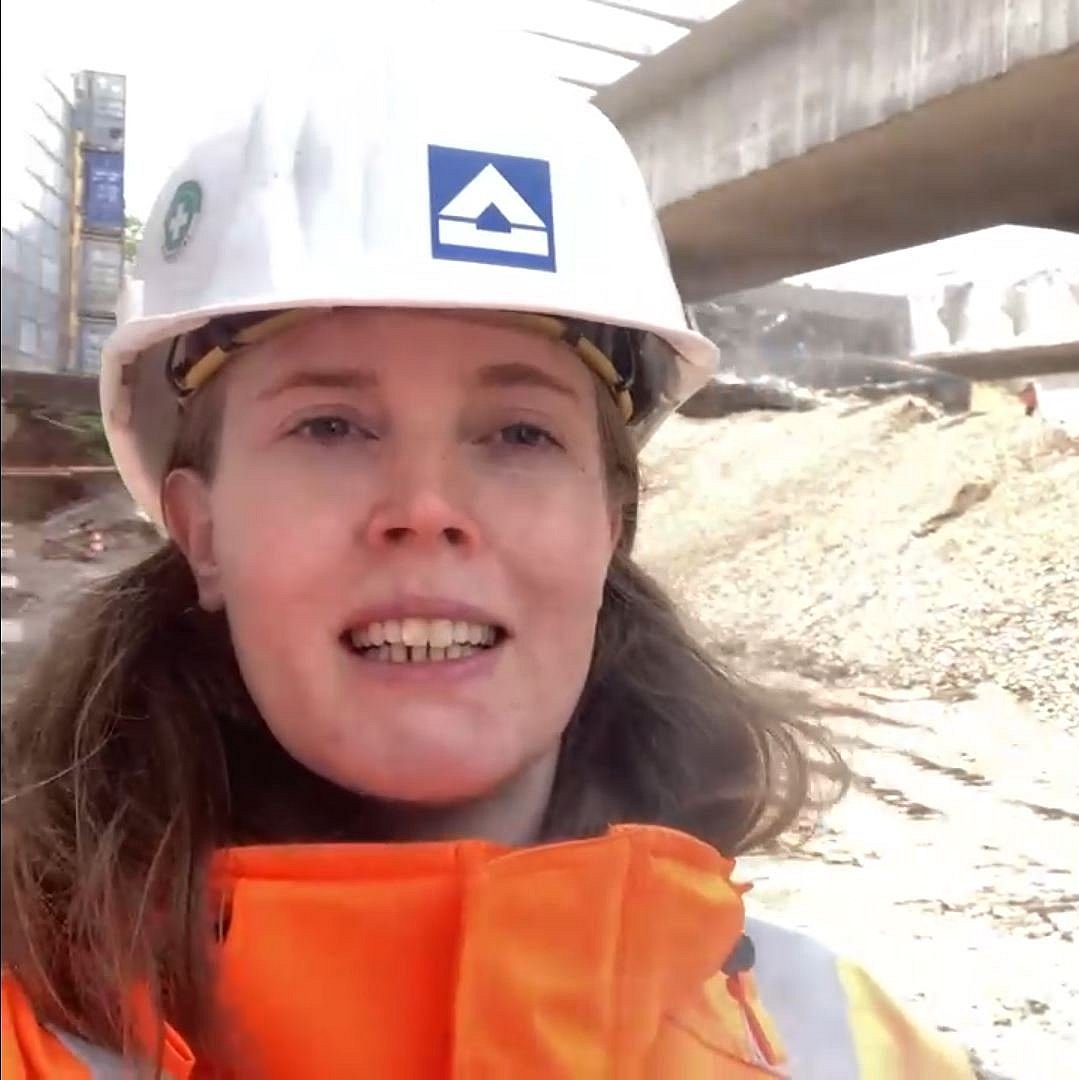Lifeline surgery
The main lifeline on the way to Cologne is beating again. On February 4, 2024, North Rhine-Westphalia's Minister President Hendrik Wüst opened the first new replacement of the A1 Rhine Bridge built by HOCHTIEF. Traffic now runs on three lanes in both directions.
Even heavy trucks, for which the dilapidated old bridge was closed for safety reasons, can cross the river again without detours. A relief not only for traffic to the Bayer and Ford plants. The old structure from 1965, once dubbed by politicians as a "monument to the catastrophic state of Germany's infrastructure," is ripe for demolition.
It is precisely this demolition that our HOCHTIEF team is organizing and getting to work on the second new replacement structure. When the second new Rhine bridge is also completed, traffic will be able to flow across eight lanes and there will be wide lanes for cyclists and pedestrians.
Our Team
Robert Büchel
The numbers man
Robert Büchel
The numbers man
Anyone who sends an invoice to their client should justify it well. Robert Büchel takes on this task. For example, if the 49-year-old does not write down exactly how many square meters of frost protection layer or how many cubic meters of concrete HOCHTIEF has processed in the past month, the company is in a fix. Büchel, who enjoys traveling in his spare time, has been working for HOCHTIEF for almost 30 years. He first trained as a carpenter, then started out in the first year of the then newly founded HOCHTIEF Academy and finally graduated as an engineer. "I then somehow slipped into my accounting job," recalls Büchel, who is currently working on several construction projects (including numerous bridges). His documents for HOCHTIEF's invoicing department are often 200 to 300 pages long, with each item neatly listed and documented. This is not necessarily everyone's cup of tea, as the numbers man knows: "Construction managers don't usually like doing this." It's good for HOCHTIEF that people like Robert Büchel sometimes find their calling when they simply "slip into" something.
Mario Dinkic
Right on schedule
Mario Dinkic
Right on schedule
Jumping out of an airplane without a plan makes little sense. Hardly anyone knows this better than Mario Dinkic. After all, the enthusiastic skydiver has done it more than 900 times—but never without a proper briefing beforehand. And because a goal without a plan is only a wish, this maxim also applies to his job. At the Leverkusen construction site, the Düren native has taken on the role of planning coordinator. "I am the interface between construction planning and execution," is how the 33-year-old describes his job. On the one hand, this applies to deadlines, but also to the actual construction. That’s why the civil engineer is often on site, ensuring that construction pits are excavated or temporary noise barriers erected as planned. Dinkic adds: "If, for example, a gas pipeline is affected by the demolition of the old bridge, I make sure that everyone involved in the process, such as the demolition company or the pipeline operator, knows exactly what needs to be done at all times." Planning is half the battle, and not just in the air.
Ahmet Karadirek
The foreman
Ahmet Karadirek
The foreman
By definition, the foreman is the "manager authorized to issue instructions to the industrial employees on a construction site". Ahmet Karadirek doesn't have to think long about whether that sums up his job correctly. "It sums it up pretty well. I organize things, order materials, assign people, check their work." Not always easy. In any case, it's a job in which the 44-year-old is constantly caught between the blue-collar and white-collar levels, between site management and subcontractors. There are sometimes conflicts that need to be resolved. In such cases, Ahmet Karadirek, who comes from Turkey and now lives in Heiligenhaus, is needed. He originally trained as a concrete worker 24 years ago at the Düsseldorf branch, where his career at HOCHTIEF began. He has been a foreman for two years now. Karadirek: "I've learned a lot from my older, more experienced colleagues. That's how it works on the construction site." This teamwork is what the father of two particularly likes about his job. And: “Everyone can see the great buildings that you create with your work. That makes you proud.”
The bridge in numbers
meters is the length of the bridge.
meters wide is the bridge.
lanes when both bridge sections are completed.
meters the pylons are towering above the roadway.
June 17, 2024
Farewell, old A1 bridge
Today, the joint venture in which our HOCHTIEF team is involved successfully divided the A1 bridge in Leverkusen into two halves. To do this, our teams cut through the webs of the bridge box girders from the middle upwards to the roadway and downwards to the outside. Everything has been prepared over the past months and weeks: Asphalt milled off, railings removed and the first bridge sections dismantled.
Then today came the decisive cut that separated the bridge into two parts. The photo gallery shows details.
Now the steel superstructure, steel cables and pylons are to be dismantled.
"Today's cutting ceremony marks the beginning of a new chapter in the history of the Leverkusen Rhine Bridge," says HOCHTIEF project manager Philip Schulze. "We have reached another milestone on the way to a more stable and sustainable infrastructure in the region."
HOCHTIEF has been working on the construction of the bridge since 2021. The first section was completed at the turn of 2024. Since February, traffic has been running on six lanes, and trucks have also been able to drive freely again. Completion of the second bridge is planned for the end of 2027.
May 23, 2024
A "drop-bed" for the Leverkusen A1 bridge
The old one has to go. Demolition of the foreland bridge on the left bank of the Rhine has begun! "First we milled asphalt, dismantled railings and the bridge sections," says HOCHTIEF site manager Bettina Henneke. "To protect the Merkenich main road below from falling bridge parts, we poured around 3,500 cubic meters of soil to create a drop bed." She explains how it works in the video.
Bettina Henneke works in the team that has taken over the continued construction of the Rhine bridge in 2021. The first section of the new bridge was completed at the turn of the year. Since February, traffic has been running across six lanes, and trucks have also been able to drive freely again. Completion of the second bridge is planned for the end of 2027.
April 16, 2024
HOCHTIEF team from Leverkusen congratulates the German champion
Teamwork is a guarantee of success. This is just as true on our construction sites, such as the A1 bridge in Leverkusen, as it is a few hundred meters away in the Bayer Leverkusen stadium. Our HOCHTIEF bridge team would like to congratulate the new German soccer champions.

The population is not quite as euphoric about a new A1 bridge as the soccer fans were on Sunday when the title was won. Nevertheless, success brings people together. That's why, after the inauguration of the first Rhine crossing at the beginning of this year, our team is moving straight on to the second new bridge. It's quite possible that Bayer's footballers will be able to celebrate their next big success a little sooner than us. Because the second highway bridge is due to be completed by the end of 2027. And Bayer is already in the DFB Cup final on May 25.
August 7, 2023
On to the second round
On we go! Together with partners, our HOCHTIEF team has been awarded the contract to build the second section of the highway bridge over the Rhine between Cologne and Leverkusen.

